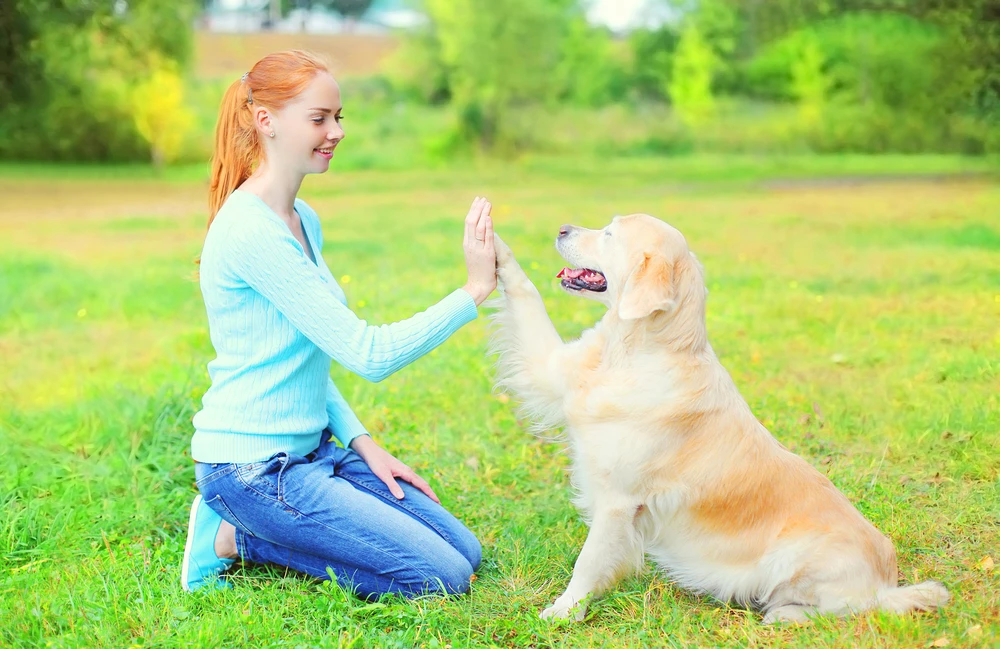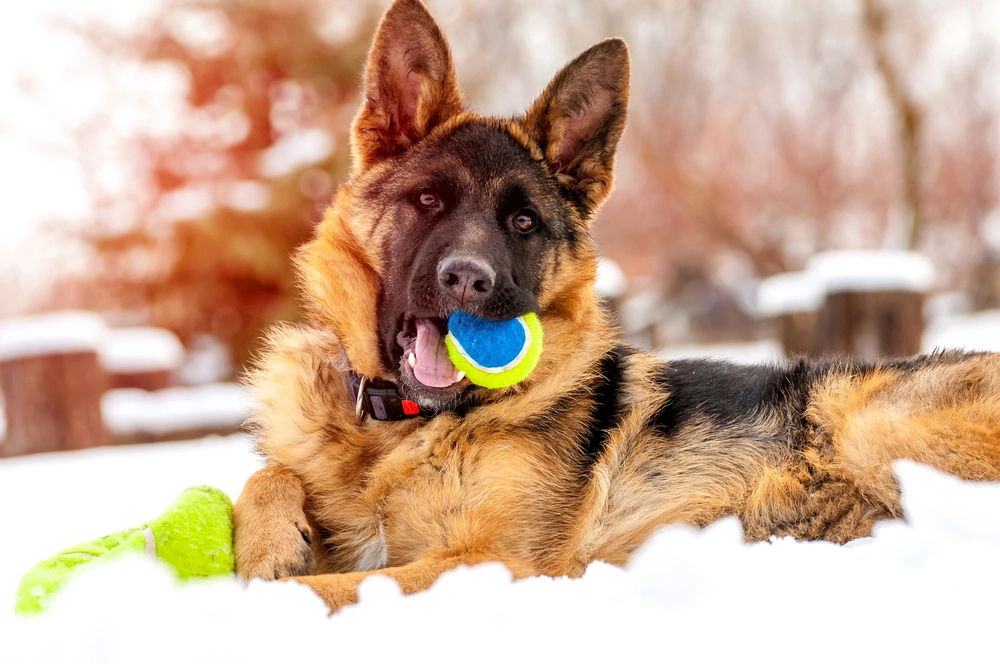
Getting a new dog is exciting, but the idea of obedience training may be less appealing. Dogs learn differently than humans, and not every pup comprehends tricks and commands quickly. Choosing an easy-to-train dog breed can make the process much simpler and less stressful, so you can get past the initial training phase and start enjoying adventures with your new furry friend.
There are several dog breeds that are easy to train, allowing for a smooth transition into their new home environment. That said, any dog breed can be easily trained with the right approach. Cesar Millan is a well-known dog behaviorist who’s written several books and starred in TV shows on dog obedience training and rehabilitation.
Millan has spent a lot of time understanding how dogs’ brains work. He interacts with and trains dogs according to their natural instincts and learning capabilities, helping them retain their newfound knowledge better. His tactics have proved beneficial in tapping into a dog’s psychology and streamlining the training process.
This article highlights the most trainable dog breeds. It offers insight into Millan’s training methods so you can help the family dog learn desirable actions and abandon unwanted behaviors in no time.
Understanding Trainability
Trainability refers to a dog’s ability to learn and pick up on training techniques quickly. For instance, if you’re practicing crate training, the goal is to get your dog to enter the crate on command. If your dog gets the hint after only a few days, its trainability is high. This is good news for you. If your dog can adapt to one command quickly, it’ll likely adapt to other commands just as easily, making the training process less tedious and time-consuming.
That said, puppy training is more than just teaching basic commands such as “sit” or “stay.” It also shapes their temperament, intelligence and behavior, helping you train dogs that know exactly what they should or shouldn’t do. This can eliminate destructive behaviors and teach your pup how to be polite, which is particularly useful when it’s playing with other dogs or guests visiting the house.
Training also provides your dog with mental and physical stimulation, helping it stay sharp and fit. It not only serves as a good source of exercise but prevents boredom and teaches your furry friend valuable problem-solving skills. This can help it navigate the world better and respond productively during anxious or unusual situations, boosting its confidence, reliability and ability to adapt to new experiences.
Keep in mind dog training isn’t just reserved for puppies. A common misconception is that older dogs can’t learn new tricks. However, dogs are capable of learning new behaviors at any age. They’re also less easily distracted past the puppy stage, which can help them focus better on the task at hand.
Some dog owners also worry about using treats during training. When done correctly, reward-based training doesn’t make dogs dependent on food forever. They can be taught to respond to commands with other rewards, including praise, privileges, petting and playing with a favorite toy.
Top 5 Easiest Dogs to Train
While all dogs make great companions, certain breeds have higher trainability due to specific traits and characteristics. Take a look at the top five easiest dogs to train to find a new furry friend to invite into your home.
1. Labrador Retriever
Labrador retrievers are friendly, sociable and eager to please, making them some of the easiest dogs to train. They’re also genetically intelligent dogs that catch on to commands and tricks quickly if you start training them as puppies.
Because they’re active dogs, they require a lot of physical stimulation. However, they’re highly reward-motivated and will easily cooperate at the promise of a treat.
2. German Shepherd
Whether they’re needed for work or family life, German shepherds make great guide dogs or herding dogs. They also have strong protective instincts and require frequent stimulation, making them great candidates for dog sports such as canine agility or disc dog.
Early training is necessary to prevent them from perceiving everything as a threat or getting into trouble. However, they’re a very intelligent breed and can become reliable, loyal pets with consistent training.
3. Golden Retriever
Happily, friendly and intelligent golden retrievers are some of the most well-behaved dogs and are likely to win high scores in obedience school. Originally bred as hunting dogs, they now serve as service dogs or therapy dogs and make great companions for children or seniors.
That said, it takes time and patience to train your golden retriever. As puppies, they have short attention spans and require constant activity, but with the right training, they’ll grow up to be mature, obedient dogs.
4. Poodle
Poodles are considered some of the smartest dogs and have sweet, lively personalities, making them easy to love. With an athletic nature and an innate desire to be the perfect companion, poodles are fast learners and crave frequent physical and mental stimulation, meaning they quickly pick up on new tricks and games.
They’re often up for a challenge, so be sure to have plenty of dog toys and games on hand. Whether you’re engaging in basic training or teaching high-level agility skills, your poodle will be a master in no time.
5. Border Collie
Quick-witted and energetic, border collies are athletic dogs that require a lot of time, attention and physical activity. Their intelligence makes them easily trainable, and their need for constant stimulation helps pet parents stay active.
Border collies are a herding breed due to their keen natural instincts and intense gaze, helping them intimidate geese and other animals. They also have great agility and typically perform well in dog sports or competitions.

Cesar Millan’s Dog Training Techniques
Cesar Millan has been in the dog training business for decades. With his experience, Millan understands that dogs have a different learning style than humans and typically retain information through clear associations and concise language.
Millan believes it’s essential to start training puppies early so you can shape their behavior rather than fixing it later. Delve deeper into Millan’s dog training methodology by exploring the following techniques.
“Pack Leader” Approach
Dogs instinctively have a “pack leader” mentality. Since they view their humans as pack leaders, your pup will look to you for guidance. If you want your dog to act or respond in a specific way, it’s crucial to provide clear, concise and consistent commands. Otherwise, it may become confused or not remember what action or behavior is expected.
It’s also important to set rules and boundaries for your dog’s safety. Once it learns certain instructions and limitations, you won’t have to worry about it ignoring you while outside or in public.
Understanding Dog Psychology
While humans learn through past memories and experiences, dogs learn through associative memory. They live in the present and can recognize a relationship between two things if those things occur at the same time.
For example, if you’re practicing crating a dog, say the command “go to crate” and offer a treat once it completes the task. Your dog will then associate the command with the treat because these things happen simultaneously.
Positive Reinforcement vs. Correction Techniques
Positive reinforcement uses rewards to encourage desirable behaviors, while correction techniques often involve punishment to deter undesirable behaviors. Because dogs learn through association, positive reinforcement is more successful in shaping behavior.
If your dog learns that engaging in a certain behavior results in it receiving a treat, it’ll make a strong association between the two events. Most dogs are reward-motivated and will respond positively when treats are involved.
Utilizing Energy and Body Language
Since dogs look to their humans for guidance, they’ll read your energy and body language to assess a situation. Exuding positive energy and open body language can encourage behaviors, while negative energy and aggressive body language may discourage behaviors.
For example, if you’re in a bad mood during potty puppy training and tug on the leash, your pup will associate wearing its leash with a negative experience. However, if you act excited when putting its leash on to go outside, it’ll form a positive association with the object and experience.
Another example is training and using customizable audio cues that only your pup knows, so if you’re on a hike and they go too far ahead, a whistle will queue them to come back safely and quickly.
The top five easiest dog breeds were chosen for their intelligence, eager-to-please personalities and athleticism, which helps them respond positively to training. If you start training your pup with these techniques while it’s young, it’ll catch on quickly, serving as a loyal, well-behaved companion for a lifetime.
Training Tips for Any Breed
Although some dogs are easier to train, any breed can learn new tricks and commands with the right approach. Here are a few training tips to follow regardless of your dog’s breed:
- Find the right reward: Rewards are essential in positive reinforcement training. Most dogs are food-motivated. That said, some may respond to anything edible, while others may have specific likes and dislikes. Other dogs may show more interest in affection or play as a reward.
- Be consistent: Consistency is key in successfully training your dog. If you’re teaching it a new command, use the same word and intonation for the same action repeatedly until it understands what to do. It’s also important to get everyone in the household on the same page to prevent confusion.
- Use short, frequent sessions: Conducting short training sessions several times per day is more effective than one hour-long session. Your dog may become distracted or frustrated during a longer session, which can impact its physical and mental health. It’s also helpful to train in multiple locations so your dog understands certain behaviors are expected no matter where it is.
- Praise generously: Simply put, dogs love praise. It’s important to celebrate and respond with positive energy and affection anytime your dog achieves a new accomplishment, no matter how small. This will motivate your dog to continuously engage in certain behaviors or try new things if it knows it’ll receive praise.
These techniques are effective in training most dogs but may need to be adapted depending on the breed and individual dog. For example, younger dogs are typically more energetic and distractible than older dogs, meaning they’ll require more patience and shorter training sessions. Some breeds, such as the Bernese mountain dog, are naturally shy and may require more attention and praise as motivation to try new things.
FAQs
Do small dogs also need training?
Small dogs may be easier to manage, but they also benefit from training. Their smaller size can make the world more intimidating, and training can help boost their confidence.
Is there a right age to begin training?
There isn’t necessarily a right age to begin training. Puppies begin learning at birth and may start to pick up on basic obedience cues or verbal commands as early as 7 or 8 weeks old.
Are there dog training programs?
There are many dog training programs offered through pet stores or within local communities. Additionally, Halo Collar offers Millan-led training programs with our Pack Member Plans.
Unlock a Happier, Well-Trained Dog: Explore Halo Collar’s Training Solutions Today!
Training your dog doesn’t have to be an overwhelming, unpleasant task. By following Cesar Millan’s dog training techniques, such as using the pack mentality approach, understanding your dog’s psychology, practicing positive reinforcement and displaying positive energy, you can teach your dog anything from basic commands to high-level tricks.
Of course, some dogs, including German shepherds and golden retrievers, are easier to train than others, but that shouldn’t deter you from getting the dog you really want. A bit of patience, consistency and your dog’s favorite treat can go a long way in shaping its behavior.
If you need a hand with dog training, check out Halo Collar’s wireless fence technology and customized training programs. The GPS-based device monitors your dogs’ activity and can be used to encourage desirable behaviors. After you try it out, let us know how it goes. We love hearing training success stories and seeing humans forge closer bonds with their furry companions.






